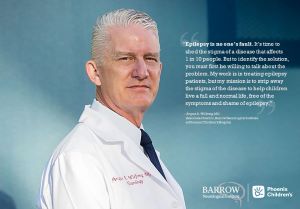“It’s not your fault.” Of all of the things I could tell a parent whose child is diagnosed with epilepsy, I always start with those four words. My reason is simple: unlike many other diseases that frequently affect children, epilepsy is still stigmatized. Often, mothers in particular wonder if they’ve done something to cause their child’s seizures.
Since the Middle Ages, seizure disorders like epilepsy have created feelings of fear, superstition and confusion. It might sound crazy, but many believed that people who suffered seizures were possessed by evil spirits. Even today, few people really understand epilepsy and, as a result, the shame and fear that accompany a diagnosis create a significant obstacle.
Unfortunately, these negative connotations have wide-ranging effects. Often, parents of children with epilepsy don’t receive the education and support they need because they’re apprehensive to share a diagnosis with their loved ones, or to advocate for their child with their primary care provider. On a larger scale, the stigma even affects the level of public and private funding available for epilepsy research, which represents just a fraction of the resources allocated to much less common neurological conditions.
On behalf of all of the children we treat at Barrow Neurological Institute at Phoenix Children’s, here are three simple facts to break that stigma and encourage support of people with epilepsy in our community.
- It’s incredibly common. More than 45,000 U.S. children are diagnosed with the condition each year – and more than 11,000 Arizona kids have active epilepsy. It’s a disease that can appear at any stage of life, though it’s most frequently diagnosed in children and the elderly.
At Barrow at Phoenix Children’s, we treat thousands of pediatric epilepsy patients every year. As a Level 4 Epilepsy Center, our program has received the highest designation possible from the National Association of Epilepsy Centers, and therefore treats some of the toughest cases. Often, families feel alone and afraid when they receive an epilepsy diagnosis, but when they arrive here, they soon realize that many other parents and children are waging a similar battle.
- Treatments are evolving. One of the most fascinating areas of my work is the research and innovation that our program leads. Epilepsy was once a very mysterious disease, but recent developments in how we understand and treat the condition have broken barriers and improved the quality of life of those living with epilepsy.
For example, epilepsy treatment was once limited to medications with varying levels of success from patient to patient. Patients who don’t respond to traditional medications face incredible challenges in school, at home and in social situations. Others require such high doses of medication that their brain function is impaired. They spend each day feeling “drugged” or “in a fog.”
It’s been uplifting, as a doctor, to help bring forth new options for treating and even curing epilepsy. Our experts use cutting-edge technology including laser ablation, vagus nerve stimulation and responsive neurostimulation to free children from seizures. Along the way, our family-centric approach includes our pediatric epilepsy monitoring unit that allows healthcare professionals to gain deeper insights into a patient’s condition and improves diagnoses and treatment plans. Earlier this year, Phoenix Children’s became the first hospital in the nation to use the Medtronic Stealth AutoGuide robotic guidance system for neurosurgeries including laser ablation. This innovative approach was pioneered by our Chief of Neurology, Angus Wilfong, MD, and has improved surgical precision to within sub-millimeter accuracy.
- A normal life after an epilepsy diagnosis is possible. November is Epilepsy Awareness Month, the perfect time to educate all Arizonans and break the stigma surrounding pediatric epilepsy. Life goes on after an epilepsy diagnosis – and it’s no one’s “fault.”
To continue innovating and identifying solutions, we must first be willing to talk about the problem – to end the stigma and shame. And that’s what we do, day in and day out. Our mission is to strip away the stigma of the disease – to help children live a full and normal life, free of the symptoms and shame of epilepsy.

